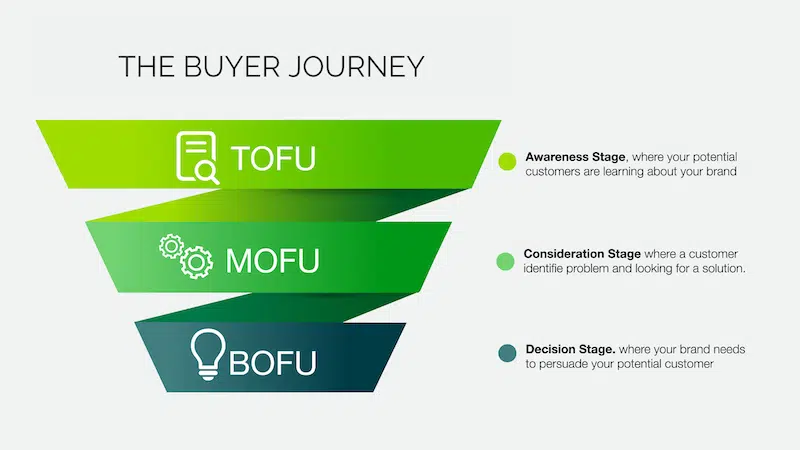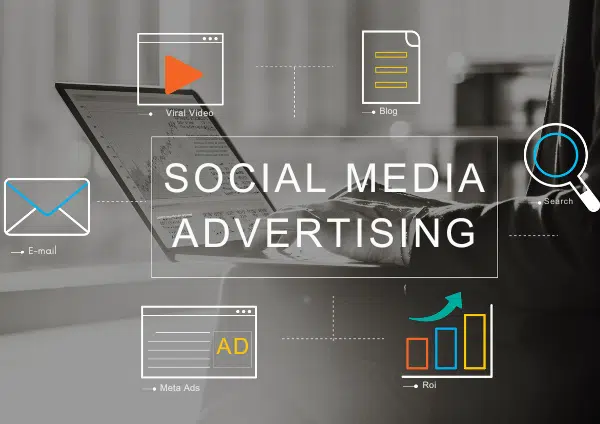Auto parts eCommerce and social media advertising go hand-in-hand. It helps your brand increase market reach, provide a new revenue stream, and drive more sales. It’s a perfect digital match.
Here’s how auto parts sellers can utilize paid social ads to support their bottom line.
Targeting Your Ads
Did you know 60% of OEM part buyers are from the Millennial and Gen Z generations? With younger digital-savvy customers who heavily utilize mobile parts shopping, you must customize your social ads to all your target audience subsets.
Tailoring ad campaigns to your segmented audiences and where they are in their buyer’s journey helps ensure you deliver relevant content and maximize your ad spend.
The buyer’s journey is categorized into three funnel stages, and here is how each stage looks using auto parts as an example:

-
Top-of-Funnel (TOFU), Awareness Stage: Target people who don’t know your brand yet. Use ads with happy customer reviews to build trust and awareness.
-
Middle-of-Funney (MOFU), Consideration Stage: Target people who are comparing your OEM parts to those from other sellers. Show carousel ads highlighting the benefits and reliability of your OEM parts to help them decide.
-
Bottom-of-Funnel (BOFU), Decision Stage: Target people ready to buy. Offer ads with holiday sales and discounts to encourage them to purchase.
If you don’t know your target audiences, conduct a buyer persona workshop with your team. Ask yourselves, “What do most of our parts customers look like?” and segment them into different lists.
Include details like age range, location, which social channels they’re on, and buying behavior (spending more if it’s faster shipping, buying used parts more because it’s cheaper, predominantly mobile shopping, etc.).
This information can be found in your customer data, such as CRM platforms, transaction history spreadsheets, email contact lists, and social media analytics.
Ad Formats and Best Practices
With so many social media advertising platforms, formats, and features to choose from, it can be challenging to navigate. Here are the most common social ad types and best practices for auto parts sellers.
Ad Formats
There are multiple types of social ads with various features depending on the platform.
The most common social ad formats with examples used in auto parts eCommerce include:
Single Image Ads
Infographics of your monthly specials or Augmented Reality (AR) ads to display your products in 3D to increase engagement, especially for mobile users.
Carousel Ads
A slideshow of images, parts inventory served from a website feed, and/or short videos of UGC reviews with customers showcasing how their vehicles improved after a part purchase.
Video Ads
Short videos showcasing your products in action, like your engine’s powertrain strength featured in a fast-accelerating car, vibrant music, and cool aesthetics.
Message Ads
Direct ad messages that appear in a user’s inbox. For example, users can comment with a specific word you set on your Instagram post that automatically DMs them a discount code. Also, LinkedIn’s Sponsored InMail messages users you may want to build connections with, like inviting local dealership owners to an automotive industry event your dealers are attending.
Story Ads
Instagram and Facebook Stories of influencers promoting your new inventory.
Social Ad Best Practices
Depending on the social platform, some advertising standards may differ.
The best paid social ad practices for auto parts dealers include:
-
Setting higher budgets for special offers and sales events, like holiday promotions and in-store anniversaries.
-
A/B testing before and after launching ad campaigns to gauge audiences on mobile and desktop to see which performs better, like static image ads vs. carousel ads.
-
Using compelling branded visuals that make users stop scrolling with valuable CTA offers, like before/after car part purchase memes or ASMR-type videos.
-
Creating different ad campaigns for each target audience segment for content relevancy.
-
Regularly monitoring and reviewing ad campaign reports to measure success with data-driven, actionable insights.
Measuring Success and Understanding Analytics
Social advertising is an investment that requires continuous monitoring to measure success effectively. That’s why your business must understand how to analyze and utilize your ad campaign metrics (KPIs) to maximize your return (ROI).
Key organic social metrics to track include:
-
Likes: Number of users who liked your ad. Measures engagement and audience approval.
-
Impressions: Number of users your ad was displayed to. Measures market reach and brand awareness.
-
Comments: Number of users who commented on your ad. Measures engagement.
-
Shares: Number of users who shared your ad. Measures engagement and content value.
-
Views: Number of users who watched your ad. Measures how compelling your ad thumbnail was.
-
Video Performance: Engagement metrics such as view count and completion rate. Measures video effectiveness.
Key paid social metrics to track include:
-
Reach: Number of unique people who see your ad.
-
Average Click-Through Rate (CTR): Measures how effectively your ad encourages clicks.
-
Results/Conversions: Number of desired actions (e.g., link clicks, form submissions, purchases) achieved.
-
Conversion Rate: Percentage of users who became customers or leads.
-
Clicks: Number of times your ad was clicked.
-
Cost-Per-Impression (CPI): Amount paid per 1,000 impressions.
-
Total Ad Spend: Total amount paid for the entire campaign.
-
Frequency: Average number of times a person sees your ad.
-
Video Performance: Engagement metrics such as view count and completion rate. Measures video effectiveness.
Your social ads’ ROI depends on your business goals and KPIs. For example, if you want to improve ad-related sales, you would evaluate if your ad’s conversions and conversion rate are increasing and improving.
Boost Your Parts Sales with Social Media Advertising
Social media advertising is a powerful tool for increasing your auto parts sales and expanding your market reach. By targeting your ads, utilizing various ad formats, and following best practices, you can effectively engage your audience and drive more traffic to your online store.
Take your social media efforts to the next level by selling parts online. RevolutionParts can help transform your parts department into a successful online business. Reach customers nationwide, increase your sales, and stay ahead of the competition.
Get a demo today or talk to one of our e-commerce experts to learn how RevolutionParts can help drive more sales and reach more customers. Start your journey towards a more profitable and wide-reaching auto parts business now!

Marketing Reach Pro
This blog was created with the help of Reach Marketing Pro, an expert in social media strategy for dealerships. They work with dealerships to strategize their social media, create engaging posts, and use the right hashtags to reach more people. Their team knows how to boost your social media presence to increase your sales.



